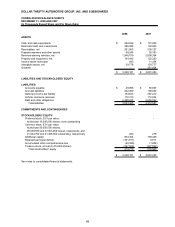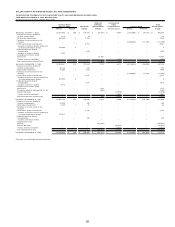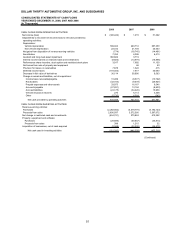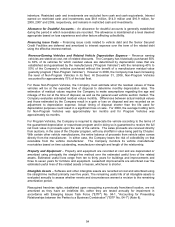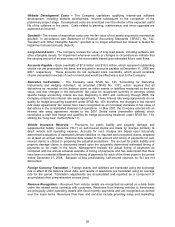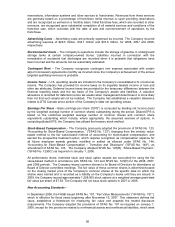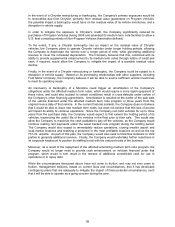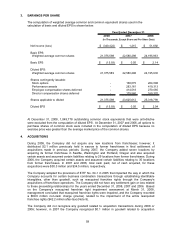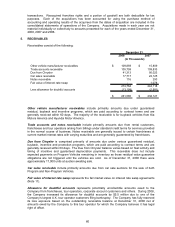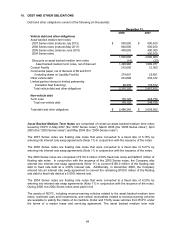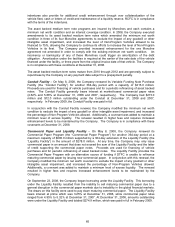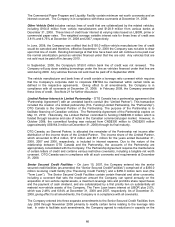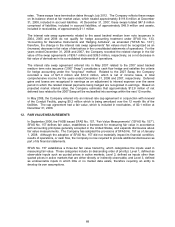Thrifty Car Rental 2008 Annual Report Download - page 60
Download and view the complete annual report
Please find page 60 of the 2008 Thrifty Car Rental annual report below. You can navigate through the pages in the report by either clicking on the pages listed below, or by using the keyword search tool below to find specific information within the annual report.In the event of a Chrysler restructuring or bankruptcy, the Company’s primary exposures would be
to receivables due from Chrysler, primarily from residual value guarantees on Program Vehicles,
the potential impact a bankruptcy would have on the residual value of its vehicle inventories, and a
disruption in vehicle supply.
In order to mitigate the exposure to Chrysler’s credit, the Company significantly reduced its
purchases of Program Vehicles during 2008 and amended its medium term note facilities to allow a
U.S. fleet consisting entirely of Non-Program Vehicles (hereinafter defined).
To the extent, if any, a Chrysler bankruptcy has an impact on the residual value of Chrysler
vehicles, the Company plans to operate Chrysler vehicles under longer holding periods, allowing
the Company to depreciate the vehicle over a longer period of time, while generating additional
revenue to cover the increased depreciation. The Company believes that this, combined with its
ability to provide supplemental enhancement to its medium term notes through letters of credit and
cash, if required, would allow the Company to mitigate the impact of a possible residual value
decline.
Finally, in the event of a Chrysler restructuring or bankruptcy, the Company could be subject to a
disruption in vehicle supply. Based on its purchasing relationships with other suppliers, including
Ford Motor Company, the Company believes it will be able to source sufficient vehicle inventories
to meet its operating needs.
An insolvency or bankruptcy of a Monoline could trigger an amortization of the Company’s
obligations under the affected medium term notes, which would require a more rapid repayment of
those notes, and could also (subject to certain conditions) result in cross-defaults under certain of
the Company’s other financing agreements. Amortization is required at the earlier of the sale date
of the vehicle financed under the affected medium term note program or three years from the
original invoice date of that vehicle. In the current financial markets, the Company does not believe
that it would be able to issue new medium term notes, but does not believe that this lack of access
will impact its ability to continue operations. Since the Company can hold vehicles for up to three
years from the purchase date, the Company would expect to first extend the holding period of its
vehicles, maximizing the useful life of the vehicles in the fleet prior to their sale. This would also
allow the Company to maximize the cash available to pay off the vehicles, as the Company would
continue making rent payments under the asset backed note program during the holding period.
The Company would also expect to immediately reduce operations, closing smaller airport and
local-market locations and retaining a presence in the most profitable locations as well as the top
75 U.S. airports. As part of this plan, the Company would also seek to franchise locations to third
parties to generate additional revenue. Finally, the Company would undertake further reductions in
its corporate headcount to position its staffing levels with the reduced scale of the business.
Moreover, as a result of the repayment of the affected amortizing medium term note program, the
Company would no longer need to provide cash enhancement on vehicles financed under that
program, which would in turn result in the release of additional unrestricted cash for use in
operations or to repay debt.
While the circumstances discussed above have not come to fruition, and may not ever come to
fruition, management believes, based on current facts and circumstances, that it has developed
contingency plans that are adequate to mitigate the impact of these potential circumstances, such
that it will be able to operate as a going concern during the year.
58



